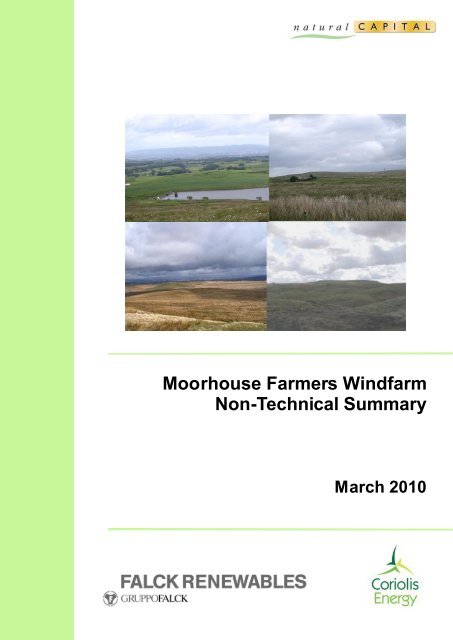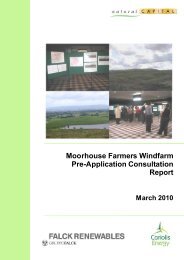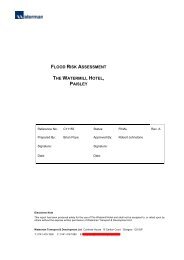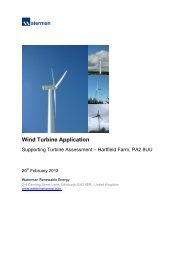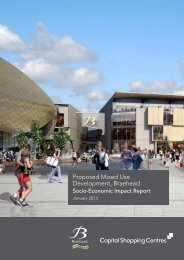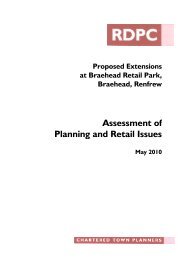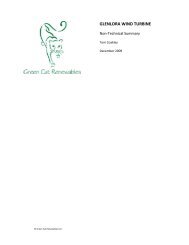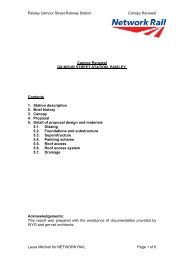Supporting documents - Renfrewshire Council
Supporting documents - Renfrewshire Council
Supporting documents - Renfrewshire Council
Create successful ePaper yourself
Turn your PDF publications into a flip-book with our unique Google optimized e-Paper software.
Moorhouse Farmers Windfarm<br />
Non-Technical Summary<br />
March 2010
MOORHOUSE FARMERS WINDFARM<br />
ENVIRONMENTAL STATEMENT<br />
NON-TECHNICAL SUMMARY<br />
INTRODUCTION<br />
This document is the Non-Technical Summary of the<br />
Environmental Statement for the Moorhouse Farmers<br />
Windfarm which is proposed by Falck Renewables.<br />
Coriolis Energy LLP is developing the proposals on behalf<br />
of Falck. The proposals are for a 19 turbine windfarm with<br />
approximately 47.5 Mega Watt (MW) capacity located on<br />
land in the Moorhouse area, to the west of Eaglesham and<br />
some eight kilometres (km) south west of Glasgow, between the M77 and the<br />
B764 Eaglesham Moor Road (see Figure 1). Five farms would have an interest in<br />
the windfarm.<br />
ENVIRONMENTAL IMPACT ASSESSMENT<br />
Coriolis Energy is submitting a planning application to East <strong>Renfrewshire</strong> <strong>Council</strong><br />
(ERC) on behalf of Falck Renewables under the Town and Country Planning<br />
(Scotland) Act 1997 as amended by the Planning etc. (Scotland) Act 2006 1 . The<br />
proposals require environmental impact assessment (EIA) under the<br />
Environmental Impact Assessment (Scotland) Regulations 1999 (as amended)<br />
(the EIA Regulations) because of the scale of the proposals and the potential for<br />
significant effects.<br />
The connection of the windfarm with the local electricity distribution network would<br />
require consent under Section 37 of the Electricity Act, 1989. This would be the<br />
subject of a separate application.<br />
The EIA has been informed by a Scoping Opinion, as permitted under the EIA<br />
Regulations, from ERC Planning and Transportation Service and consultations<br />
with a wide range of organisations and landowners. This information and the<br />
findings of the assessments have been used to help develop the design of the<br />
windfarm by ensuring that wherever possible, adverse effects on people and on<br />
the natural and cultural environment would be avoided and environmental benefits<br />
delivered.<br />
The findings of the environmental impact assessment and details about the project<br />
including mitigation commitments (measures that would be implemented to avoid,<br />
reduce or remedy adverse environmental impacts) are presented in the<br />
Moorhouse Farmers Windfarm Environmental Statement. The Environmental<br />
Statement comprises two volumes: Volume 1 containing the main text, annexes<br />
and appendices and Volume 2 containing the figures This Non-Technical<br />
Summary summarises the findings of the EIA and other key information contained<br />
in the Environmental Statement.<br />
1 Electricity generation projects below 50MW are authorised under the Town and Country Planning (Scotland)<br />
Act, 1997. Those over 50MW are authorised under Section 36 of the Electricity Act, 1989<br />
I
Pre-Application Consultation (PAC)<br />
The project is defined as a major project under the Town and Country Planning<br />
(Hierarchy of Developments) (Scotland) Regulations 2009. Pre-application<br />
consultation (PAC) between the developer and local community has thus been<br />
carried out in accordance with the Town and Country Planning (Development<br />
Management Procedure (Scotland) Regulations 2008 and the relevant provisions<br />
of the Town and Country Planning (Scotland) Act 1997 as amended by the<br />
Planning etc. (Scotland) Act 2006. The PAC procedures were agreed with ERC<br />
and included a public exhibition in Eaglesham on 20 th October 2009.<br />
PROJECT NEED<br />
Recent legislation has set tough targets for cutting greenhouse gas emissions in<br />
the UK. In Scotland the long-term target is to reduce Scotland’s emissions of<br />
greenhouse gases by at least 80% by the year 2050 with a 2020 interim target of<br />
42% and a framework of annual targets intended to drive the policies necessary<br />
for achieving the long-term target. The Renewable Energy Directive (2008) 2<br />
requires that 22% of all energy in the European Union is to be generated from<br />
renewable sources by 2020, split between Member States in a ‘burden sharing<br />
scheme’. The UK portion is 15% of the total energy requirement, which includes<br />
energy for transport etc. In November 2007, the Scottish Government committed<br />
in its Government Spending Review 3 that 31% of electricity would be generated<br />
from renewable sources by 2011 and 50% by 2020.<br />
The Moorhouse Farmers Windfarm would contribute to a net reduction of carbon<br />
dioxide emissions.<br />
PROJECT OBJECTIVES<br />
The objectives which have been defined to underpin the development of the<br />
proposals are:<br />
to safely construct and operate a windfarm with a design life of at least 25<br />
years;<br />
to integrate successfully with other land uses in the area taking account of<br />
landowner interests;<br />
to safeguard the quality of surface and groundwater and minimise water<br />
crossings where practicable;<br />
to safeguard the natural and cultural heritage of the area, where practicable;<br />
to design, as far as practicable considering other constraints, a windfarm that<br />
visually integrates with Whitelee Windfarm;<br />
to avoid significant effects on peat where these could be avoided 4 ;<br />
to be a well maintained and sustainable business contributing to the delivery of<br />
UK and Scottish renewable energy and carbon reduction targets; and<br />
to produce a robust, cost effective design that is transferable to construction<br />
whilst taking account of environmental constraints.<br />
2 Directive of the European Parliament and of the <strong>Council</strong>, On the Promotion of the Use of Energy from<br />
Renewable Sources, Commission of the European Communities, 2008<br />
3 Scottish Budget Spending Review, Scottish Government, 2007<br />
4 For example by the use of floating roads on deep peat<br />
II
ALTERNATIVES<br />
Coriolis developed a relationship with the five farmers who have an interest in the<br />
development having identified a suitable wind potential in the area for a windfarm.<br />
The site was also considered to be suitable as the proposals could be designed as<br />
far as possible, within the site constraints, to integrate with the existing Whitelee<br />
Windfarm. No site alternatives were considered outwith this location although the<br />
actual area of the proposed development has evolved.<br />
Various conceptual layouts for the windfarm have been considered by Coriolis<br />
Energy to check the viability of the site. These environmental layouts have been<br />
developed further as the constraints on the site for each discipline were better<br />
understood and as part of an iterative design process involving the project team and<br />
consultees. The application layout for the windfarm turbines and access tracks is<br />
now considered to be best fit for the site.<br />
THE PROPOSALS<br />
The proposed site is situated approximately 2km west of Eaglesham. It is set on the<br />
gentle hills between the A77 to the west, A726 to the north and B764 to the south<br />
east. On the western boundary of the site lies Eastwood Golf Course with Bonnyton<br />
Golf Course situated on the eastern boundary.<br />
The key components of the proposals as shown on Figure 2 are:<br />
19 wind turbines;<br />
up to three permanent lattice construction anemometer masts 5 ;<br />
a permanent access route into the site from the B764;<br />
access tracks and underground cabling within the site;<br />
an on-site control building including the electrical substation;<br />
associated communications and other infrastructure; and<br />
three temporary borrow pits (at East Moorhouse; South Moorhouse and<br />
Shieldhill).<br />
The turbines would be of a typical modern design incorporating tubular towers and<br />
three blades attached to a nacelle housing the generator, gearbox and other<br />
operating equipment. The exact model of turbine to be used would be decided by a<br />
procurement process after consent. The proposed turbines would be semi-matt pale<br />
grey in colour with a capacity of 2-3MW and an expected capacity factor 6 of<br />
approximately 30%. They would have a probable rotor diameter of about 92 metres<br />
(m) and a hub height of 80m, making up a tip height of approximately 126m. The<br />
turbine revolution speed would be approximately 18 revolutions/minute. The turbines<br />
would carry no external advertising or lettering apart from required statutory notices<br />
and a turbine number on each door. The turbine choice would take account of the<br />
potential for reflected light to cause disturbance and a suitable model would be<br />
installed which would avoid this.<br />
Some 11.1km of access tracks would be required of which some 2km would be<br />
floating roads. Most tracks would be approximately 8m in width during construction<br />
and designed in accordance with best practice. At the end of construction in most<br />
locations tracks would be reduced to 5m in width.<br />
5 The existing temporary mast would be removed<br />
6 The ratio of actual productivity to the maximum theoretical productivity of the windfarm<br />
IV
DELIVERING THE PROPOSALS<br />
If at the conclusion of the statutory process it is found that the proposals should be<br />
taken forward there would be a competitive tendering process to select a contractor<br />
for the scheme. The winning contractor would construct the works in accordance<br />
with requirements set out in the contract. These would include all the committed<br />
environmental mitigation described in the Environmental Statement.<br />
Where details of the project have still to be finalised assumptions have been made in<br />
the Environmental Statement to allow potential impacts to be considered and<br />
appropriate mitigation to be identified. If as the detailed proposals are developed,<br />
any significant effects were identified which were considered to be greater than those<br />
reported in the Environmental Statement an addendum would be published for public<br />
consultation and comment and further consideration by ERC.<br />
It has been assumed that the permanent features of the windfarm (turbines, masts,<br />
access tracks and buildings) would be sited in the locations as shown on Figure 1.<br />
As the detailed design progresses and more information is found out about actual on<br />
the ground conditions etc it could be possible that it would be necessary to microsite<br />
some of the new infrastructure. Pre-construction ecological surveys could also<br />
define new constraints. It is therefore proposed that limits of deviation (LODs) of<br />
50m in any direction would be adopted to facilitate this micrositing. A change control<br />
process would be agreed with ERC to demonstrate that such a proposed move<br />
would result in no environmental effects greater than those set out in the<br />
Environmental Statement.<br />
CONSTRUCTION<br />
Construction by the chosen contractor would begin following agreement of the<br />
detailed design and consent conditions with ERC and other relevant statutory<br />
authorities. Construction activities would include:<br />
construction of an access road into the site and to the first borrow pit;<br />
construction of all access tracks having established all required borrow pits;<br />
design and installation of temporary and permanent drainage measures;<br />
construction of the temporary site compound;<br />
excavation of cable trenches;<br />
laying of electricity and communications cables in trenches;<br />
construction of the turbine foundations;<br />
delivery and installation of turbine towers and installation of nacelles and blades;<br />
construction of on-site control building including the substation;<br />
erection of anemometer masts; and<br />
site restoration using removed materials and turfs.<br />
The proposals would take some nine months to build. It has been assumed that<br />
construction activities would be undertaken during the daytime (assumed to be 07.00<br />
to 19.00 Monday to Friday and 07.00 to 13.00 on Saturday). Noise limits would be<br />
controlled by consent conditions set by ERC.<br />
The contractor would be required to develop and implement an environmental<br />
management plan (EMP) for construction following best practice. The EMP would<br />
consist of a suite of <strong>documents</strong> in addition to the main document. These would<br />
include but not be limited to:<br />
VI
a Road Safety and Traffic Management Plan;<br />
a Water Protection Plan;<br />
an Ecological Management Plan;<br />
a Landscape Management Plan;<br />
a Traffic Management Plan;<br />
a Noise Management Plan<br />
a Post Construction Restoration Plan; and<br />
a Decommissioning Plan.<br />
At the end of construction the contractor would be required to restore all areas of the<br />
site which were no longer required for activities during operation of the windfarm.<br />
DECOMMISSIONING<br />
Decommissioning of the windfarm site would take place once the site ceases<br />
operation (after approximately 25 years). The general method statement for<br />
decommissioning would be agreed with ERC in advance of these works beginning.<br />
The Decommissioning Plan in the EMP would set out the environmental protection<br />
measures and restoration principles which would be implemented during the works.<br />
EFFECTS OF THE PROPOSALS<br />
The environmental effects of the proposals are summarised in the following sections.<br />
Effects which are moderate or major (adverse or beneficial) are considered to be<br />
significant.<br />
Policy and Planning<br />
The proposals broadly follow Scottish Government guidance and the relevant<br />
Structure Plan policy framework and comply with most Local Plan Policies relevant to<br />
the proposals. The development would contribute towards meeting the Scottish<br />
carbon reduction target for the year 2020 and 2050 and renewable electricity targets<br />
as described above.<br />
The proposals are within the identified broad area of potential search for windfarm<br />
developments in the Glasgow and Clyde Valley Joint Structure Plan. The proposed<br />
site is zoned as Countryside Around Towns in the East <strong>Renfrewshire</strong><br />
<strong>Council</strong> Adopted Local Plan (2003). In the Finalised Local Plan (2008) the proposed<br />
site is zoned as Countryside Around Towns however the majority is also zoned as<br />
Renewable Energy, which supports the development of this proposal. A small<br />
section in the north eastern part of the proposed site is solely zoned as Countryside<br />
Around Towns.<br />
The majority of the proposals would be sited within the area zoned as Renewable<br />
Energy. Two turbines MHT-16 and MHT-17 and the substation (as shown on Figure<br />
2) would however be located in the area solely zoned as Countryside Around Towns,<br />
where if the proposals satisfy Finalised Local Plan Strategy: Assessment of<br />
Development Proposals and the Policy: Green Belt and Countryside Around Towns<br />
criteria then it would comply with policy. The environmental assessment indicates<br />
that the necessary criteria of these policies would be met.<br />
Seven Sites of Importance for Nature Conservation (SINCs) lie within, partly within or<br />
in proximity to the proposed site. Three of these sites would be directly affected.<br />
The assessment indicates that the integrity of the affected sites would not be<br />
compromised and therefore the proposal complies with the policy in the Local Plan<br />
which protects them.<br />
VII
Traffic and Access<br />
The proposals would cause an increase in traffic on local roads during construction<br />
and this could be particularly noticeable in the peak hour period. The worst effects<br />
would be limited to a three month period and are not predicted to result in significant<br />
traffic disruption or severance/amenity effects.<br />
Each turbine would require delivery of nine abnormal loads. The access route for<br />
these would be likely to be from either King George V Docks in Glasgow or Ayr<br />
Docks and via the trunk road network as much as possible to reduce the potential for<br />
impacts on local communities. A Section 96 agreement would be entered into so<br />
that any damage to the road network during construction would be repaired. The<br />
traffic effects would be minor during operation of the windfarm (vehicles for a<br />
workforce of two and traffic required for maintenance activities).<br />
Land Use, Property and Agriculture<br />
The majority of the site is currently used for cattle and<br />
sheep grazing. Surrounding land uses in the area include<br />
Whitelee Windfarm, forestry, agriculture (mainly grazing),<br />
golf courses and residential with the proposed site lying<br />
approximately 2km west of Eaglesham and some 3km<br />
south of Newton Mearns. Bennan Loch and Lochcraig<br />
Reservoirs, owned and operated by Scottish Water, are<br />
located in the centre of the site and are public water<br />
supplies. There is a gas distribution compound on the eastern edge of the site<br />
approximately 0.5km north east of East Moorhouse and four Scotland Gas Networks<br />
gas pipelines run across the site. There are various electricity supplies on site and<br />
two overhead telephone lines cross the site.<br />
There are scattered properties around the site. No residential properties would be<br />
directly affected by construction. Residents and local businesses would be informed<br />
of the sequence of construction activities including blasting (if required) and the<br />
contractor would be required to keep disruption to a minimum. There could be some<br />
short term minor (not significant) disruption to traffic on the B764 used for access to<br />
the site by construction vehicles. Access would be maintained for all properties<br />
during construction and when the windfarm was operational access would be open<br />
for recreational users (walkers and cyclists).<br />
Pipelines would be protected from any potential impact during construction. Where<br />
an access track crosses the Eaglesham to Kilmarnock pipeline no works would begin<br />
until detailed consultation had been undertaken with<br />
Scotland Gas Networks and detailed construction<br />
methodology and mitigation measures agreed.<br />
Construction of the proposals would result in a<br />
permanent change in land use of approximately 10.3ha<br />
of non-prime agricultural land to land used for<br />
infrastructure for renewable energy, although once built<br />
the rest of the site would remain in its current use<br />
(grazing). The proposals would result in a temporary change in land use of some<br />
9.1ha for land used for crane hardstandings and borrow pits. This land would be<br />
restored on completion of construction and some could be suitable for grazing in the<br />
future.<br />
VIII
Geology, Soils and Contaminated Land<br />
No sites designated for their geological interest would be affected by the proposals.<br />
No geological resources of particular significance have been identified which would<br />
be affected by the works and no significant effects are predicted.<br />
Peat is commonly found across the site ranging in depth from very shallow to more<br />
than 3m. A peat slip hazard assessment has been undertaken which indicates that<br />
hazards can be mitigated by implementation of mitigation measures in the detailed<br />
design and the risk of peat slide of the mitigated design would not be significant.<br />
No significant areas of contaminated land have been identified which could be<br />
affected by the works. An area of potentially contaminated land was identified by<br />
ERC some 100m south east of turbine MHT-114. This would be investigated prior to<br />
construction commencement and if contaminated the contractor would be required to<br />
avoid the area of contamination and ensure that all potential indirect effects were<br />
mitigated. Implementation of best management practices including good design of<br />
the works would ensure that any impacts to soils were minimised. Implementation of<br />
best management practices and the committed mitigation measures would ensure<br />
that any risk of subsidence due to the decomposition of buried peat would be avoided<br />
and the risk of peat slides minimised.<br />
The total carbon emission generated by construction of the proposals is 130,772<br />
tonnes of carbon dioxide per year (tCO2 yr -1 ). Taking into account the estimated<br />
carbon dioxide savings which would be generated by the windfarm then the overall<br />
payback time in terms of carbon dioxide emissions for the proposals is calculated to<br />
be 1.7 years.<br />
Water Quality and Drainage<br />
There would be no significant effects on hydrology,<br />
water quality and drainage provided all mitigation<br />
measures were successfully implemented. No known<br />
private water abstractions would be affected by the<br />
development and groundwater supplies would be<br />
protected by design of the works in accordance with<br />
best practice.<br />
The contractor would be required to develop and<br />
implement a Water Protection Plan as part of the site EMP to ensure proactive<br />
protection of watercourses, groundwater and potable water supplies including the two<br />
public water supply reservoirs. All design and protection measures (permanent and<br />
temporary) would be agreed with SEPA and Scottish Water in advance of<br />
construction. Flood risk would be appropriately mitigated and would not be<br />
significant.<br />
Best management practices would be implemented during construction and<br />
maintenance activities during operation to ensure there was no significant impact on<br />
water quality. There would be minor adverse effects during construction and the<br />
contractor would be required to monitor the effectiveness of all protection measures<br />
during all phases of construction. Accidental spills and leaks would be dealt with as<br />
part of the emergency response plan and all site staff would be trained on its<br />
implementation.<br />
IX
Landscape and Visual Effects<br />
Effects on the Landscape<br />
Direct effects on landscape resources due to the loss or alteration of features,<br />
including those at the site of the borrow pits would not be significant when examined<br />
in the context of the wider landscape. The new windfarm would serve as a new, yet<br />
not unfamiliar, landscape feature. There would be significant adverse indirect<br />
changes to landscape character as a consequence of the physical changes within<br />
the development site. These would mainly affect the local landscapes around the<br />
windfarm. Landscapes closer to the site, and those which cover higher ground,<br />
would be those which would be most affected, due to the potential intervisibility of<br />
these areas with the proposed turbines. These include some landscapes which are<br />
already affected by an existing windfarm and those which will also be affected by<br />
consented windfarms. Lower lying features such as the borrow pits would have no or<br />
very limited effect upon wider landscape character.<br />
The proposed location of the windfarm would result in the turbines being seen as part<br />
of the Whitelee Windfarm when viewed from the landscapes to the south, and south<br />
east, and as such the landscape character of these areas would not be affected.<br />
Similarly, when seen from the north west the proposed turbines would lie directly in<br />
front of those at Whitelee and so would appear to be part of the same larger<br />
windfarm. To the north and north east, and to an extent to the east and south south<br />
west, the urban areas of Glasgow, East Kilbride and Kilmarnock and Irvine would<br />
result in there being no significant effects upon<br />
landscape character across these extensive areas,<br />
as views would largely be blocked by existing built<br />
development or would be seen in an urban context.<br />
No nationally or locally designated landscapes<br />
would be directly affected. Some localised indirect<br />
non significant effects upon designated landscapes<br />
would be apparent on the edge of Cathkin Braes<br />
Country Park and Clyde Muirshiel Regional Park.<br />
Effects on Visual Amenity<br />
There would be some significant adverse effects upon visual amenity from closer<br />
locations, including from the range of residential properties that lie around the<br />
periphery of the development area and recreational viewers using footpaths and<br />
visiting locations of interest. Residential viewers close to the development area<br />
would experience significant effects due to the proximity of the turbines and the<br />
prolonged nature of their view, although as existing windfarms are already present<br />
and others consented, people would already be familiar with the sight of turbines.<br />
Some recreational viewers would experience significant effects due to the close<br />
proximity at which turbines would be viewed, but again turbines are a familiar sight to<br />
many already.<br />
The majority of significant effects would affect closer locations. It is only from the<br />
closest of locations that lower level features such as roads and borrow pits would<br />
also be seen. Elsewhere effects upon visual amenity would result primarily from the<br />
turbines. From the north west of the proposed windfarm, visibility would be relatively<br />
limited, reflecting the location of the development, which provides a degree of visual<br />
X
screening and prevents there from being a direct line of sight to lower locations.<br />
Figures 3 and 4 are visualisations of the proposed development.<br />
During construction and decommissioning there would be effects upon the landscape<br />
and visual amenity arising from plant and activities within the development area over<br />
the duration of the works. These would include the presence of tall cranes in views,<br />
and lower level disturbance, particularly around the turbine foundations, tracks and<br />
borrow pits.<br />
Other Landscape and Visual Effects<br />
Once the windfarm was operational there would be occasional infrequent<br />
requirements to repair or replace defective components. Because of their short term<br />
nature, these would not give rise to significant effects on landscape or landscape or<br />
visual amenity.<br />
Cumulative effects (and additional effects over and above those existing as a<br />
consequence of windfarm developments which already exist) upon landscape and<br />
visual amenity would also result, due to the number of other existing and proposed<br />
developments in the area. The design of adjacent windfarms so that they work well<br />
together and effectively read as a single development reduces cumulative effects<br />
considerably across what may already be described as a landscape with windfarms.<br />
The proposed development provides an opportunity to visually link separate<br />
scattered existing, consented and proposed windfarms across the area, particularly<br />
Whitelee Windfarm with the proposed Harelaw Renewable Energy Park, in order that<br />
they read as a single continuous large windfarm, located across this medium to large<br />
scale landscape.<br />
Ecology and Nature Conservation<br />
No statutory designated sites would be directly impacted on by the proposals.<br />
Protected species interests have been identified on site (bat, otter and badger) but<br />
none would be directly affected by the development. Mitigation measures<br />
implemented during construction would ensure that any effects would be minor and<br />
not significant. Some birds of conservation concern have been identified as breeding<br />
on parts of the site lapwing, common gull, common sandpiper, curlew, grey wagtail,<br />
kestrel, redshank, red grouse, snipe and tufted duck. The bird collision risk modelling<br />
and bat survey work indicate that there would be no significant risks to birds or bats<br />
once the windfarm was operational. The effects on other species would not be<br />
significant. The contractor would be required to develop an Ecological Management<br />
Plan as part of the site EMP to ensure that all wildlife interests were protected and<br />
effects on habitats and fauna reduced to the minimum necessary for the works.<br />
Three SINCs would be directly affected by construction. These are Ballageich Bog,<br />
Floak Bridge and Shieldhill Bog. The quality of habitats in the SINCs has been<br />
affected by many years of farm improvement activities and none of the mire or other<br />
habitat is of more than local value. Effects would be reduced by careful design and<br />
planning to ensure that the risk of further indirect habitat loss was minimised. The<br />
area of any SINC affected would be small and the integrity of the sites would be<br />
maintained. The potential effects on the affected SINCs are considered to be minor.<br />
Some further habitat of local value would be lost outwith the SINCs but again this has<br />
been modified by man’s activities and the effect is not considered significant.<br />
XI
Non-Technical Summary<br />
Figure 3<br />
Photomontage includes some Whitlee Windfarm Turbines as these were constructed when the base photograph was taken. Size A4: Not to scale - information above applicable to A3 size figure presented in Moorhouse Farmers Windfarm Environmental Statement Volume 2: Figures
Non-Technical Summary<br />
Figure 4<br />
Size A4: Not to Scale - information above aplplicable to A3 size figure presented in Moorhouse Farmers Windfarm Environmental Statment Volume 2: Figures
Some 2km of floating road would be used in appropriate locations and the design of<br />
all access tracks would seek to maintain the current hydrology to avoid impacts on<br />
adjacent habitats. The nature conservation interests of the watercourses and the<br />
reservoirs would be protected by implementation of mitigation measures set out in a<br />
Water Protection Plan.<br />
There would be some disturbance during construction from increased activity on site.<br />
This would be short term (construction would take some nine months) and no<br />
significant effects have been identified. Impacts from maintenance and<br />
decommissioning activities would be controlled by implementation of mitigation as<br />
during construction and works would be overseen by<br />
an environmental clerk of works.<br />
At the end of construction and again after<br />
decommissioning the site would be restored in all<br />
areas apart from where some infrastructure would<br />
be left in place.<br />
Coriolis Energy and Falck have committed to discussing mitigation planting with<br />
some landowners in proximity to the site who would be interested in this at the<br />
detailed design stage and the plans would be developed as part of the Habitat and<br />
Landscape Management Plan included in the site EMP. The new landscape<br />
proposals would be designed to provide a range of habitats for birds and other<br />
animals and have potential to enhance local biodiversity in the longer term.<br />
Archaeology and Cultural Heritage<br />
A review of the historical and cartographic evidence for the general area and specific<br />
development area describes settlement from the early prehistoric period to the recent<br />
past. Traces of fortification, house platforms and funerary monuments are evident<br />
particularly on higher ground. Peat cover may obscure more extensive settlement<br />
evidence. Early medieval settlement is best exemplified by castles and motte sites in<br />
the general area while some of the present field boundaries within the development<br />
area may relate to medieval (or earlier) farm sites. Eighteenth century<br />
improvements are most marked within the development area in terms of the<br />
Moorhouse Farm group, with the planned village of Eaglesham, numerous improved<br />
farms and large formal estates in the general area. More recent development is<br />
characterised by limited industrialisation in terms of water supply management and<br />
quarrying.<br />
There are 424 sites of archaeological or historical interest within the development<br />
area. Of these 89 lie within 50m of proposed turbine sites and associated<br />
infrastructure. There are 38 sites of archaeological or historical interest in the wider<br />
area of the development area boundaries. These include eight Scheduled Ancient<br />
Monuments (SAMs), 13 ‘A’ Listed properties, two sites listed in the Inventory of<br />
Gardens and Designed Landscapes and one Conservation Area.<br />
The proposed development would have a direct impact on 46 sites of local or less<br />
importance. Where a physical impact is predicted, the preferred option would be to<br />
microsite the development away from the affected site. Where this is found not to be<br />
possible the site would be tested archaeologically to establish extent and character of<br />
the site. If the site is to be destroyed in part or in total, a programme of<br />
archaeological excavation would be implemented and the scale and scope of this<br />
agreed in consultation with relevant agencies. If the proposed works impact on an<br />
area of agreed archaeological potential then a programme of archaeological<br />
XIV
monitoring would be implemented. The scale and scope of all excavation,<br />
monitoring and subsequent post fieldwork requirements would be agreed in<br />
consultation with relevant agencies. Provided all agreed mitigation was implemented<br />
the residual effects on the directly affected sites would not be significant.<br />
The consideration of impact on the setting of relevant sites has shown only one<br />
moderate adverse effect – site I, Ballagioch Cairn. All other sites have either minor<br />
adverse or no significant impact on setting.<br />
Noise and Vibration<br />
The completed assessment has considered the potential impacts that could occur<br />
during both the construction and operation of the proposed development.<br />
Noise predictions have been undertaken to determine potential impacts on existing<br />
local noise sensitive receptors (including the closest residential properties to the<br />
proposed development) during the operation of the proposed windfarm.<br />
Consideration has been given to the local properties that have, or do not have, a<br />
financial involvement in the proposed development. A detailed baseline noise survey<br />
was undertaken to inform the assessment of noise from the proposed development<br />
once operational. The effect of the Whitelee Windfarm and proposed extension was<br />
taken into account in the assessment.<br />
An assessment of potential construction noise was undertaken and even when<br />
adopting a series of worst case assumptions, predicted construction noise levels<br />
have been predicted to fall below a criterion applicable to rural areas, at the closest<br />
residential dwellings to the site. Notwithstanding this, a series of good practice<br />
construction noise mitigation measures would be implemented. At worst, a<br />
temporary adverse minor noise effect would arise from construction noise at local<br />
properties.<br />
Vibration and air overpressures that could be generated if blasting was required at<br />
the proposed borrow pits could be controlled to appropriate levels at residential<br />
properties. Groundborne vibration levels arising from possible blasting could also be<br />
controlled to appropriate levels at underground services with the agreed mitigation<br />
measures in place.<br />
The proposed turbine layout has been prepared following a detailed iterative design<br />
process taking into account the prevailing local noise environment and associated<br />
constraints. Assessment of the final scheme design has identified that the applicable<br />
noise level limits stated in ETSU-R-97 (prepared by the Energy Technical Support<br />
Unit for the Department for Trade and Industry) would not be exceeded with the<br />
candidate turbines used for the assessment operating in unconstrained mode. At<br />
worst, the effect would be negligible/minor (not significant) at local properties from<br />
the operation of the proposed windfarm. Plant noise levels limits have been<br />
calculated for the control of noise from the proposed transformers and the control<br />
building/substation and at worst, again, an adverse noise effect of negligible or minor<br />
level (not significant) would arise at local properties as a result of noise from<br />
proposed plant items.<br />
Air Quality<br />
No significant effects on air quality are predicted during construction, operation and<br />
decommissioning provided all mitigation measures are successfully implemented.<br />
There would be no significant direct effects on local or global air quality. There would<br />
XV
e an indirect benefit on local and global air quality from the generation of electricity<br />
from a renewable source rather than from burning fossil fuel.<br />
Shadow Flicker and Icing<br />
Any potentially significant effect of shadow flicker would be mitigated and the effects<br />
would not be significant. There would be no significant health related effects from the<br />
turbines once operational. There would be no significant effects from ice throw on<br />
people or livestock.<br />
Telecommunications and Aviation<br />
The layout of the windfarm has been designed to avoid impacts on fixed<br />
telecommunications. Pre and post-construction surveys would<br />
determine any effects on television reception and signal quality<br />
would be restored where required by established technical<br />
measures.<br />
The proposals would not present an obstacle hazard to aircraft.<br />
The windfarm would have no impact on military aviation or<br />
defence activities. The windfarm would be within the line of<br />
sight of the air traffic control radars at Glasgow and Prestwick<br />
Airports and Lowther Hill. Mitigation of the effects on Glasgow Airport and Lowther<br />
Hill would be achieved through blanking of the affected radar's coverage and<br />
provision of in-fill data from the radar at Kincardine. As part of the pre-application<br />
consultations Prestwick Airport has indicated that is has no objection to the<br />
development.<br />
Socio-Economic Effects<br />
The access tracks for the windfarm would benefit recreational users in the area by<br />
providing further opportunities for walking and cycling. This could increase numbers<br />
at local attractions. The windfarm has been designed such that it would effectively<br />
read as one with Whitelee Windfarm and the Whitelee Windfarm is already proving to<br />
be an attraction for visitors.<br />
Construction of the windfarm would create some 50 jobs over a nine month period<br />
and at least some of these are likely to be from the local area. There would also be<br />
some indirect benefits from supply of materials and induced benefits from spend by<br />
those employed on the site. Employment on the site, once the windfarm was<br />
operational would be small apart from at times of major maintenance.<br />
The developer would make an annual contribution to a community fund which could<br />
help deliver local projects. There would be opportunities for the community in<br />
proximity to the windfarm to invest in it if they chose to do so. Income to the farm<br />
businesses involved in the development would receive a long term improvement<br />
which could assist in maintaining rural employment and activity.<br />
OTHER CUMULATIVE EFFECTS<br />
The nature conservation interests of the site could be affected by a combination of<br />
effects including those resulting from habitat loss, disturbance, loss of peat and<br />
pollution. The project would be developed in an area which has already been<br />
modified by man’s activities and this combined with the identification of a wide variety<br />
of mitigation measures which would be implemented would reduce the risk of<br />
cumulative impact to minor (not significant).<br />
XVI
The various impacts of construction on watercourses and the public water supplies<br />
would be carefully managed through detailed design, implementation of all controls in<br />
the site EMP and Water Protection Plan and in the actions included in activity specific<br />
method statements. The requirement for any additional mitigation measures would<br />
be highlighted at an early stage and throughout the construction period through<br />
careful monitoring of all the potential impacts on site.<br />
Residents in proximity to the proposals could be affected by a combination of traffic,<br />
air quality, noise and reduction in amenity effects. There would be some effects<br />
during construction with increased traffic movements on local roads and visual<br />
effects from construction plant etc. This would be short term and the contractor<br />
would be required to monitor effects and to reduce the level of impact to the minimum<br />
necessary for safe implementation of the works. The windfarm has been designed to<br />
a high standard to ensure that it would fit well in the landscape (which is already in<br />
parts dominated by the Whitelee Windfarm) and that operational effects (noise etc)<br />
would be managed and monitored and adequately controlled to not cause significant<br />
effects.<br />
The findings of the search for projects which could be built within a similar time frame<br />
as the windfarm indicated the potential for some other windfarms to be under<br />
construction in the area surrounding Eaglesham. It is presumed that similar access<br />
routes could be used for construction as for the Moorhouse Farmers Windfarm. If<br />
this were to be the case then construction traffic could be greater than assumed in<br />
the assessment, but it is considered unlikely that effects in any location would be<br />
significant. The potential for cumulative noise and dust effects has not been<br />
identified because there are no known significant proposals in close proximity of the<br />
site.<br />
There are no other major proposals which have been identified which have been<br />
consented and no other significant effects from the combined impacts of the<br />
proposals with those from other proposals are predicted.<br />
REVIEW AND COMMENTS<br />
Upon receipt of a valid planning application, East <strong>Renfrewshire</strong> <strong>Council</strong> will then<br />
undertake neighbour notification (and public advertisement if required) and invite<br />
formal representations and objections to the proposal, which the <strong>Council</strong> will take into<br />
account before reaching a decision.<br />
The Environmental Statement can be viewed during the consultation period during<br />
normal working hours at:<br />
The offices of East <strong>Renfrewshire</strong> <strong>Council</strong> Headquarters<br />
Eastwood Park<br />
Rouken Glen road<br />
Giffnock<br />
G46 6UG<br />
The Environmental Statement can also be viewed on the Moorhouse Farmers<br />
Windfarm website: http://www.moorhousefarmerswindfarm.co.uk/<br />
The Environmental Statement comprises two volumes: Volume 1 containing the<br />
main text, annexes and appendices and Volume 2 containing the figures, and also<br />
this Non-Technical Summary (NTS) which is bound into the front of the Volume 1 and<br />
is also available as a free-standing document.<br />
XVII
Copies of the Environmental Statement are available from Natural Capital Ltd in hard<br />
copy for £150 or on CD for £10 (both including postage and packing). VAT is<br />
chargeable on CDs.<br />
Natural Capital Ltd<br />
13 Coates Crescent<br />
Edinburgh<br />
EH3 7AF<br />
XVIII
Natural Capital Ltd<br />
13 Coates Crescent<br />
Edinburgh<br />
EH3 7AF<br />
Tel: 0131 220 6121<br />
Fax: 0131 220 6131<br />
Email: info@naturalcapital.co.uk


